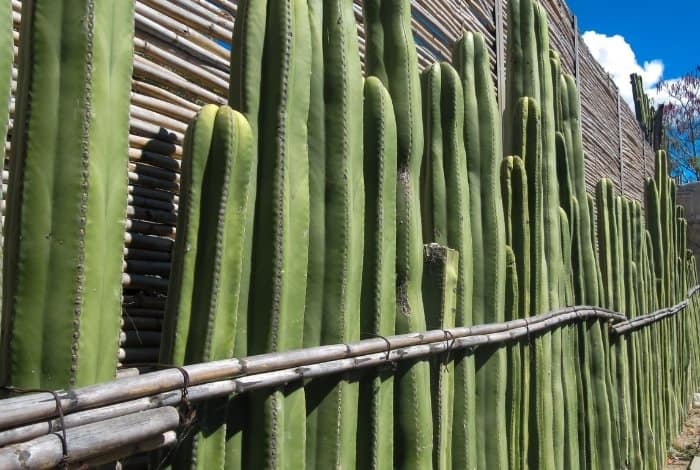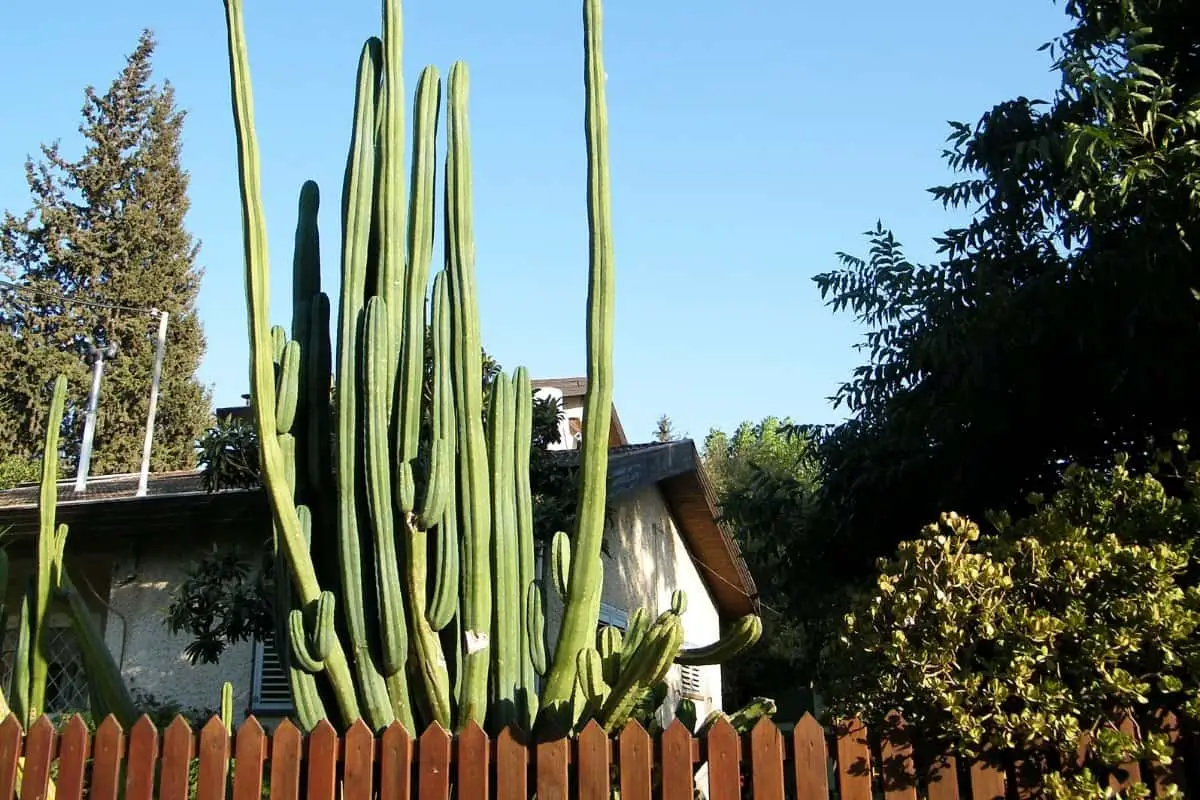Last Updated on December 30, 2022 by Griselda M.
The San Pedro cactus growth rate is one of the rarest in the world of cacti because it is not affected by either cold or hot weather. Echinopsis pachanoi/Trichocereus pachanoi as it is known scientifically is a popular cactus in desert gardening. It gets this name from a hairy floral tube.
San Pedro Cactus is ornamental and has been used for thousands of years as a traditional psychedelic medicine in South America due to the presence of mescaline. That’s why it comes as no surprise when it is given over 25 different names. This cactus is grown for both ornamental and medicinal use around the world.
Growing San Pedro Cacti
Growing this cactus is easy because it is quite forgiving. It also requires only small amounts of water and nutrients. The cactus will tolerate temperatures that dip below freezing for a day or two, and my cacti survived snow twice. They are however more suited to growth in USDA zones 8b. This means you can comfortably grow your cactus outdoors if you live in areas that are zone 8b and above. Below that, keep it in a pot and move it indoors for winter.
These cacti do not need a lot of water to grow healthy but like other plants, they need care, love, and attention. When you choose to grow it indoors, place it next to a well-lit window and water it more often, especially during summer days. I have an avenue of these growing in a seepage zone below my reservoir and can confirm they will even thrive in waterlogged clay soil. Some of these plants are 20 feet high.
The San Pedro Cactus Growth Rate Defined
The San Pedro cactus grows very fast especially if the climate is friendly. If they are planted in good soil and watered more often during the summer season, they will thrive. Established San Pedro cactus plants can grow up to 30 cm/11 inches in a year.
You can prevent these fungal infections by planting in well-drained soils and watering them with adequate water. Also, allow the plant to get plenty of heat.
Watering Trichocereus Pachanoi
The San Pedro Cacti prefer a dry environment like most cacti. Cacti are generally sensitive to watering. This is the number one cause of death in this cactus. That said, I have grown them basically in a swamp and they did ok.

When grown outdoors, they will need adequate water in summer and minimal water in the cold months. Cold weather prevents the water from evaporating and your cacti can sit in damp soil for too long. This promotes rot that leads to death. This should be avoided at all costs.
Do not forget to add some nutrients from time to time. The NPK is an ideal fertilizer for cacti. I personally just mulch my cacti and the mulch feeds them. I also give them wood ash twice a year for potassium.
Propagating San Pedro Cactus
- Remove these offsets properly, and make a clear cut with a clean, sharp knife. Be sure to cut as close to the stem as possible.
- Place these fresh-cut offsets on a piece of clean paper and allow it to dry a little.
- Cut the offset at the narrowest space possible and let it callous for a few days
- Once it is calloused, place it in a container that has drainage holes and some well-drained soil.
- Any time you plan to re-pot San Pedro Cactus, make sure it is during the warm season. Before you repot ensure the following is in place:
- The soil should be dry to prevent damaging the roots
- Remove as much soil as possible to remove any rotten or dead roots
- Look out for pests and diseases and treat them with a fungicide
- Put the plant in its new pot or container and spread the roots as much as you can while adding fresh soil.
- Allow the plant to rest for a few days before you start watering. Start watering lightly until the plant adjusts to its new environment.
- Remember to wear your gardening gloves when handling this cactus because it has some stiff spines.
How Deep to Plant San Pedro Cactus?
If I have harvested a San Pedro cactus I usually cut a piece of the growth tip about 10 inches long and allow this to form a callus (takes a week in the shade). I then plant this to a depth of about two to three inches in the soil. San Pedro can be planted deeper in the soil – roots will grow from where the thorns are. Typically if you plant the cactus too deep it may rot.
I have found the easiest way to get a lot of cacti quickly is actually just to lay a long piece of San Pedro cactus on the top of the soil and push a bit of topsoil against each side. It will then put roots out from the thorn areas touching the ground and will put shoots out from the top of the plant. If you put a piece that is a yard long onto the ground, you should get 6-7 shoots growing up from this in a year.
Does San Pedro Cactus Grow Arms?
Yes. The plants will start growing arms when they get to about 6-7 feet tall. These often break off and fall on the ground during windy patches, and when this happens the pieces on the ground will root!
Where Can You Buy a San Pedro Cactus?
You can normally get it from a nursery. Due to its use as a psychedelic, certain areas of a more close-minded nature may limit or control the sale. If you search on mental health and micro-dosing forums on the internet, you will often find somebody willing to make plant cuttings available to you. In some cases, the plant may not be labeled as “San Pedro” but will just be sold as “cactus” and you need to do the identification of the plant.
Check your local laws and find out if it is legal to grow in your area, and this will determine how you plant it, where you plant it, and if you plant it. In most cases, it is legal to grow, but not to consume. This creates a problem if you have taken cuttings from the plant and some over-attentive person thinks you may have consumed these cuttings, rather than using them for planting.
When Does The San Pedro Cactus Flower?
This will depend on where you live. My experience with mine is that once mature, they tend to bloom mid-summer. This will really depend on your climate and photoperiod as it is the day length that acts as a trigger.
How Much Sun Does San Pedro Cactus Need?
The more sunlight the better for these plants. That said I have grown them in shaded places where they only get a few hours of direct sunlight a day and they do quite well. Due to the complexities around the legality of the cultivation of these plants, many cultivators may find that growing them near hedges and so on will limit prying eye issues.
I would suggest trying to ideally place them in a location where they will get a minimum of 5 hours of direct sunlight in winter, and as much as possible in summer.
Conclusion
FAQs
How fast does San Pedro cactus grow?
The San Pedro cactus is a type of tree that is native to Mexico and Arizona. It can grow as tall as 15 feet. The plant has spread throughout the world because of its medical properties. The cactus contains two active compounds: mescaline and mescaline derivatives which are hallucinogens that generate psychedelic effects. The plant has also been used to treat depression in humans by increasing serotonin levels in the brain.
The San Pedro is one of the most popular cacti that grows quickly and can live for more than 70 years. It’s also known as the "cactus tree" or "tree cactus." It usually grows up to 8 feet but can grow up to 50 feet if conditions are right.
How tall can a San Pedro cactus grow?
A San Pedro cactus, also known as the saguaro, can grow up to 10 feet tall if it is not exposed to too much shade.
The plant typically grows in full sun and sandy soil. It doesn't thrive well in heavy clay soil or under water, but can tolerate a range of climate conditions from desert to habitat.
San Pedro cacti are native to the Sonoran Desert of North America and have been cultivated for centuries.
Can I grow San Pedro cactus indoors?
Yes, you can! San Pedro cactus is a succulent that can be grown indoors. These plants are native to Mexico and Guatemala. They are not only easy to grow but also require little care and maintenance.
Why is my San Pedro cactus turning yellow?
There are many reasons why a cactus can turn yellow, which includes the following:
* Disease
* Over watering
* Insect infestation
* Excessive sunlight
* Extreme temperature changes
* Too much or too little soil in the pot.
How do you fertilize San Pedro cactus?
San Pedro cactus is a succulent plant that needs to be watered every other day (like all plants) and fertilized with a complete, high-quality fertilizer.
You can fertilize San Pedro cacti by putting your hand into the soil around their base and scooping up some of the soil, then mixing it with peat moss or other organic compost.
How do you fix yellow cactus?
Yellow cactus care is important for these plants to grow in a healthy manner. If you don't properly care for them, they will start to break down and die. Here are some tips on how you can get the best out of your yellow cactus:
1) Drain the soil from around the roots of the plant before planting it in a new pot
2) Water your plant until water comes out at least halfway up the stem of each plant
3) Care for your cactus with a little bit of dead grass or pine needles sprinkled on top
How do I make my cactus greener?
What are some ways to make my cactus greener? There are many things you can do to make your cactus greener. The best thing you can do is to plant it in soil, not just in the ground. When you plant it in soil, the roots of your cactus will have a better chance of growing.
The key to making your cactus greener is to water it less. The best time for watering is during the morning hours when the soil is still moist and not too hot or in the evening hours when the sun has set and the temperature has dropped.
The other important factor to consider when watering your cactus is to avoid over-watering. Over-watering can cause root rot, a disease that affects any plant by damaging its roots and will kill it if left untreated. If you notice that your plant seems like it needs more water, try watering less often instead of more often.
Caroline is a gardener who loves to get down to the nitty–gritty of gardening. She proudly proclaims herself as a ‘dirt worshipper‘ and can often be found deep in the garden, covered in soil and singing to her plants. As a self–proclaimed ‘plant whisperer‘, Caroline believes that plants need love and attention just like any other living thing, and she loves to give them both. When she‘s not tending to her garden, you can often find her researching the latest gardening trends, or teaching others how to make their gardens thrive



